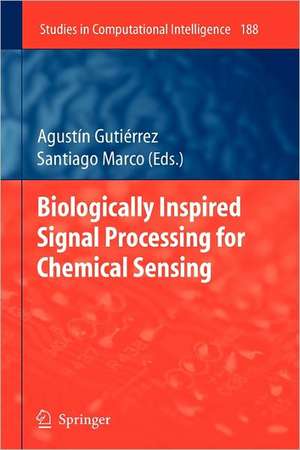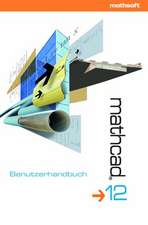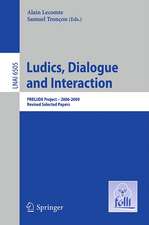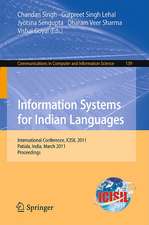Biologically Inspired Signal Processing for Chemical Sensing: Studies in Computational Intelligence, cartea 188
Editat de Agustín Gutiérrez, Santiago Marcoen Limba Engleză Paperback – 28 oct 2010
| Toate formatele și edițiile | Preț | Express |
|---|---|---|
| Paperback (1) | 640.05 lei 6-8 săpt. | |
| Springer Berlin, Heidelberg – 28 oct 2010 | 640.05 lei 6-8 săpt. | |
| Hardback (1) | 646.12 lei 6-8 săpt. | |
| Springer Berlin, Heidelberg – 11 mai 2009 | 646.12 lei 6-8 săpt. |
Din seria Studies in Computational Intelligence
- 20%
 Preț: 449.37 lei
Preț: 449.37 lei - 20%
 Preț: 1158.26 lei
Preț: 1158.26 lei - 20%
 Preț: 986.66 lei
Preț: 986.66 lei - 20%
 Preț: 1452.76 lei
Preț: 1452.76 lei - 20%
 Preț: 168.78 lei
Preț: 168.78 lei - 20%
 Preț: 1291.10 lei
Preț: 1291.10 lei - 18%
 Preț: 1112.30 lei
Preț: 1112.30 lei - 20%
 Preț: 565.39 lei
Preț: 565.39 lei - 20%
 Preț: 649.28 lei
Preț: 649.28 lei - 20%
 Preț: 1047.73 lei
Preț: 1047.73 lei - 20%
 Preț: 1578.96 lei
Preț: 1578.96 lei - 20%
 Preț: 643.50 lei
Preț: 643.50 lei - 20%
 Preț: 657.49 lei
Preț: 657.49 lei - 20%
 Preț: 993.28 lei
Preț: 993.28 lei - 20%
 Preț: 990.80 lei
Preț: 990.80 lei - 20%
 Preț: 989.96 lei
Preț: 989.96 lei - 20%
 Preț: 1165.69 lei
Preț: 1165.69 lei - 20%
 Preț: 1444.52 lei
Preț: 1444.52 lei - 20%
 Preț: 1041.96 lei
Preț: 1041.96 lei - 20%
 Preț: 1047.73 lei
Preț: 1047.73 lei - 20%
 Preț: 1046.06 lei
Preț: 1046.06 lei - 18%
 Preț: 2500.50 lei
Preț: 2500.50 lei - 20%
 Preț: 989.13 lei
Preț: 989.13 lei - 20%
 Preț: 1165.69 lei
Preț: 1165.69 lei - 20%
 Preț: 1164.05 lei
Preț: 1164.05 lei - 20%
 Preț: 1042.79 lei
Preț: 1042.79 lei - 20%
 Preț: 1460.19 lei
Preț: 1460.19 lei - 18%
 Preț: 1403.52 lei
Preț: 1403.52 lei - 18%
 Preț: 1124.92 lei
Preț: 1124.92 lei - 20%
 Preț: 1039.47 lei
Preț: 1039.47 lei - 20%
 Preț: 1008.11 lei
Preț: 1008.11 lei - 20%
 Preț: 1045.25 lei
Preț: 1045.25 lei - 20%
 Preț: 1275.42 lei
Preț: 1275.42 lei - 20%
 Preț: 1040.32 lei
Preț: 1040.32 lei - 20%
 Preț: 988.32 lei
Preț: 988.32 lei - 20%
 Preț: 1169.79 lei
Preț: 1169.79 lei - 20%
 Preț: 1162.37 lei
Preț: 1162.37 lei - 20%
 Preț: 1059.26 lei
Preț: 1059.26 lei - 20%
 Preț: 1164.05 lei
Preț: 1164.05 lei - 20%
 Preț: 1166.52 lei
Preț: 1166.52 lei - 20%
 Preț: 1459.38 lei
Preț: 1459.38 lei - 18%
 Preț: 1005.74 lei
Preț: 1005.74 lei - 20%
 Preț: 997.38 lei
Preț: 997.38 lei - 20%
 Preț: 1055.94 lei
Preț: 1055.94 lei - 20%
 Preț: 1284.47 lei
Preț: 1284.47 lei - 20%
 Preț: 994.08 lei
Preț: 994.08 lei - 20%
 Preț: 1048.72 lei
Preț: 1048.72 lei - 20%
 Preț: 1066.02 lei
Preț: 1066.02 lei - 20%
 Preț: 943.78 lei
Preț: 943.78 lei - 20%
 Preț: 1173.10 lei
Preț: 1173.10 lei
Preț: 640.05 lei
Preț vechi: 800.06 lei
-20% Nou
Puncte Express: 960
Preț estimativ în valută:
122.49€ • 127.41$ • 101.12£
122.49€ • 127.41$ • 101.12£
Carte tipărită la comandă
Livrare economică 14-28 aprilie
Preluare comenzi: 021 569.72.76
Specificații
ISBN-13: 9783642101212
ISBN-10: 3642101216
Pagini: 184
Ilustrații: XIII, 169 p.
Dimensiuni: 155 x 235 x 10 mm
Greutate: 0.27 kg
Ediția:Softcover reprint of hardcover 1st ed. 2009
Editura: Springer Berlin, Heidelberg
Colecția Springer
Seria Studies in Computational Intelligence
Locul publicării:Berlin, Heidelberg, Germany
ISBN-10: 3642101216
Pagini: 184
Ilustrații: XIII, 169 p.
Dimensiuni: 155 x 235 x 10 mm
Greutate: 0.27 kg
Ediția:Softcover reprint of hardcover 1st ed. 2009
Editura: Springer Berlin, Heidelberg
Colecția Springer
Seria Studies in Computational Intelligence
Locul publicării:Berlin, Heidelberg, Germany
Public țintă
ResearchCuprins
Biological Olfaction.- “Sloppy Engineering” and the Olfactory System of Insects.- From ANN to Biomimetic Information Processing.- The Sensitivity of the Insect Nose: The Example of Bombyx Mori.- Multivariate Analysis of the Activity of the Olfactory Bulb.- Artificial Olfaction and Gustation.- Improved Odour Detection through Imposed Biomimetic Temporal Dynamics.- Relating Sensor Responses of Odorants to Their Organoleptic Properties by Means of a Biologically-Inspired Model of Receptor Neuron Convergence onto Olfactory Bulb.- A Novel Bio-inspired Digital Signal Processing Method for Chemical Sensor Arrays.- Monitoring an Odour in the Environment with an Electronic Nose: Requirements for the Signal Processing.- Multivariate Calibration Model for a Voltammetric Electronic Tongue Based on a Multiple Output Wavelet Neural Network.
Textul de pe ultima copertă
This volume presents a collection of research advances in biologically inspired signal processing for chemical sensing. The olfactory system, and the gustatory system to a minor extent, has been taken in the last decades as a source of inspiration to develop artificial sensing systems. The performance of this biological system outperforms in many aspects that of their artificial counterpart. Thus, the goal of researchers in this field is to understand and capture those features that make the olfactory system especially suited for the processing of chemical information. The recognition of odors by the olfactory system entails a number of signal processing functions such as preprocessing, dimensionality reduction, contrast enhancement, and classification. Using mathematical models to mimic the architecture of the olfactory system, these processing functions can be applied to chemical sensor signals. This book provides some background on the olfactory system including a review on information processing in the insect olfactory system along with a proposed signal processing architecture based on the mammalian cortex. It also provides some bio-inspired approaches to process chemical sensor signals such as an olfactory mucosa to improve odor separation and a model of olfactory receptor neuron convergence to correlate sensor responses to an odor and his organoleptic properties.
Caracteristici
Presents recent research in Biologically inspired signal and data processing Includes supplementary material: sn.pub/extras
















